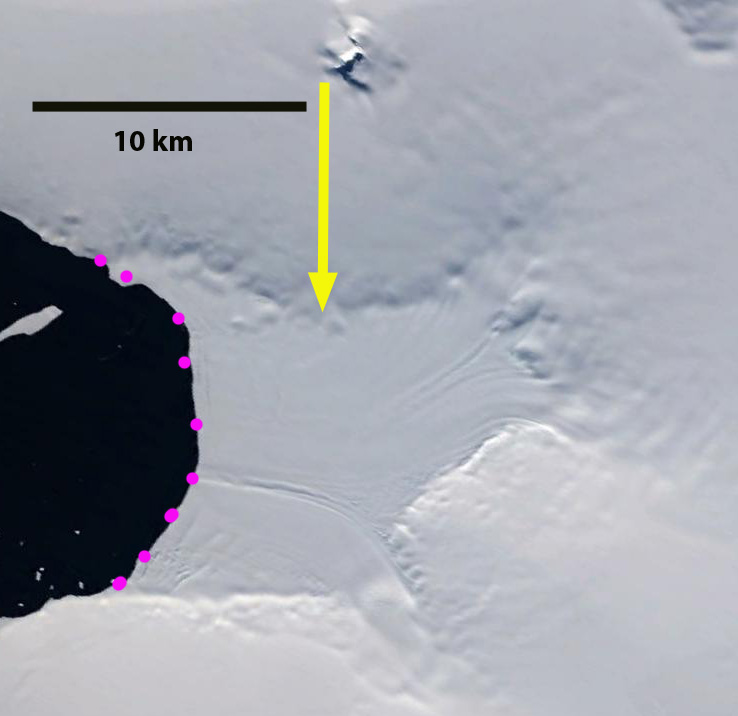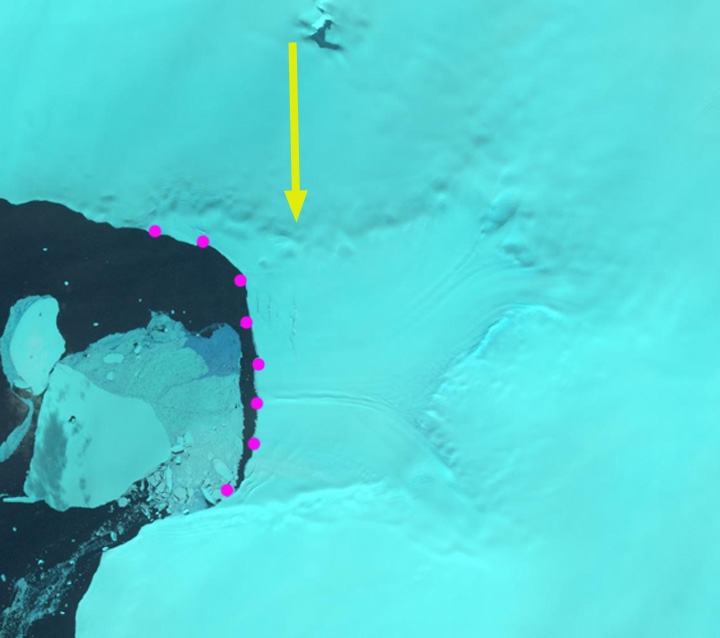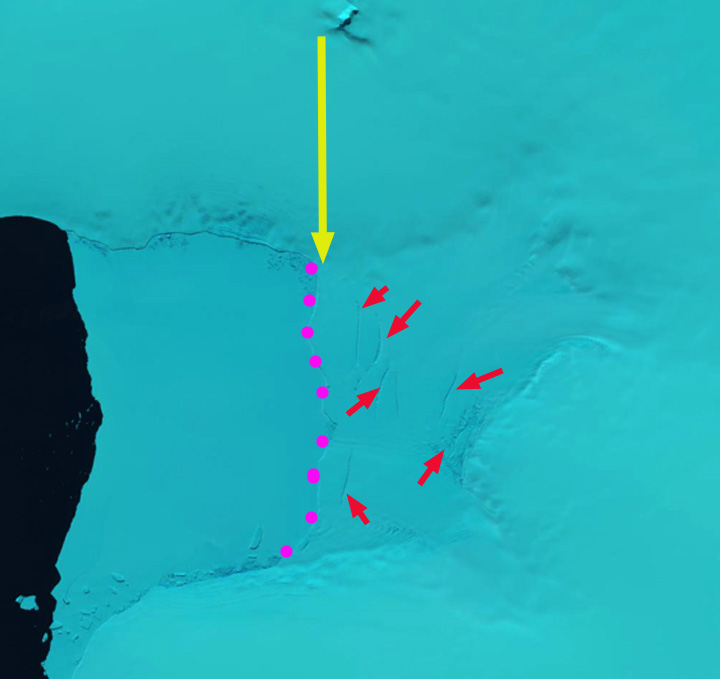May 17, 2015
Developing Instability of Verdi Ice Shelf, Antarctica: Extensive Rift Formation
Posted by Mauri Pelto
The Verdi Ice Shelf is a small ice shelf on the Beethoven Peninsula of Alexander Island on the Antarctic Peninsula. Its small size limits its global importance, but it does provide an excellent example of the rapid development of rifting that indicates potential instability. An ice shelf is a floating portion of a glacier, it buttresses glaciers that drain into it and is in turn buttressed by pinning points along the margin and within the ice shelf provided by islands and ice rises. Ice Shelf processes are well described by Davies (2014).
Cook and Vaughan (2010) observed that in recent decades, seven out of twelve larger ice shelves around the Antarctic Peninsula have retreated significantly or been almost entirely lost. This is a pattern of behavior that indicates the ability of ice shelves to collapse entirely or significantly in a short period of time. A recent paper by Holland et al (2015) noted that the much larger Larsen C Ice Shelf is thinning from above and below. The thinning of an ice shelf is the essential pre-conditioning for collapse (Pelto, 2008). NASA last week also predicted the demise within five years of the remaining portion of Larsen B.
Holt et al (2013) outlined several key glaciological characteristics as typically preceding recent ice shelf collapses:
(1) Sustained ice-front retreat, resulting in a frontal geometry that bows inwards towards its centre from both lateral pinning points (Doake et al., 1998);
(2) Continued thinning from atmospheric or oceanic warming (Shepherd et al., 2004);
(3) An increase in flow speed:
(4) Structural weakening, such as rifting along suture zones (Glasser and Scambos, 2008), and also rifting transverse-to-flow due to changing stress regimes within the ice shelf (Braun et al., 2009). Braun et al (2009) note that for Wilkins Ice Shelf just to the north of Verdi Ice Shelf surface melt and drainage of melt ponds into crevasses were not relevant for break-up. Increased buoyancy forces from thinning caused rift formation before the break-up in February 2008 was the key. Glasser et al (2011) examined the Röhss Glacier following the 1995 collapse of the Prince Gustav Ice Shelf, Antarctic Peninsula identifying the development of numerous structural discontinuities: rifts, crevasses and melt ponds on the ice shelf before the collapse.
Here we examine Landsat imagery of Verdi Ice Shelf from 2000-2014. To identify both frontal changes and structural changes.

Map of the Verdi Ice Shelf region taken from the USGS Palmer Land Map.
The above map indicates retreat of 1.5-2 km of the ice front from 1973-2001 and that the front is bowed inward at the center meeting the first criteria noted above. In each image the yellow arrow indicates the 2001 ice front of Verdi Ice Shelf on the northeast side. The pink dots in each image is the complete ice front. The red arrow indicate large rifts visible in the Landsat images, which have a 30 m resolution. In 1999 there are no major visible rifts. There are a few minor rifts close to the ice front. The maximum length of the ice shelf is 14.5 km. In 2001 the frontal position has not changed significantly and no significant rifts are visible. In 2003 the ice front has retreated 0.5-1 km, there are two minor visible near the ice front, to the left (west) of the yellow arrow. In 2013 and 2014 the maximum length of the ice shelf has declined to 12.5 km, a 2 km retreat in 15 years. More importantly there are now six significant rifts in the ice shelf, including two well back of the ice front. The rifts range from 2-4 km in length, a significant portion of the entire ice shelf width. The most inland rifted area noted occurs at the inland edge of the ice shelf and instead of a single rift is an area of numerous smaller rifts. The rapid development of the rifts suggests the ice shelf has thinned to a point of instability. This does not mean it will disintegrate entirely or immediately, but does suggest that most of the ice shelf is poised to collapse in the next decade.
Similar recent ice shelf changes reviewed are: Jones Ice Shelf and Wordie Ice Shelf. The understanding of the processes has taken detailed field work by many field teams. Examples being the LARsen Ice Shelf System, Antarctica (LARISSA) team and the British Antarctic Survey supported research at James Ross Island and Wilkins/Larsen Ice Shelf.







 Dean of Academic Affairs at Nichols College and Professor of Environmental Science at Nichols College in Massachusetts since 1989. Glaciologist directing the North Cascade Glacier Climate Project since 1984. This project monitors the mass balance and behavior of more glaciers than any other in North America.
Dean of Academic Affairs at Nichols College and Professor of Environmental Science at Nichols College in Massachusetts since 1989. Glaciologist directing the North Cascade Glacier Climate Project since 1984. This project monitors the mass balance and behavior of more glaciers than any other in North America.